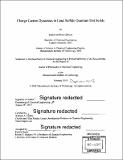Charge carrier dynamics in lead sulfide quantum dot solids
Author(s)
Gilmore, Rachel Hoffman
DownloadFull printable version (20.76Mb)
Other Contributors
Massachusetts Institute of Technology. Department of Chemical Engineering.
Advisor
William A. Tisdale.
Terms of use
Metadata
Show full item recordAbstract
Quantum dots, also called semiconductor nanocrystals, are an interesting class of materials because their band gap is a function of the quantum dot size. Their optical properties are not determined solely by the atomic composition, but may be engineered. Advances in quantum dot synthesis have enabled control of the ensemble size dispersity and the creation of monodisperse quantum dot ensembles with size variations of less than one atomic layer. Quantum dots have been used in a variety of applications including solar cells, light-emitting diodes, photodetectors, and thermoelectrics. In many of these applications, understanding charge transport in quantum dot solids is crucial to optimizing efficient devices. We examine charge transport in monodisperse, coupled quantum dot solids using spectroscopic techniques explained by hopping transport models that provide a complementary picture to device measurements. In our monodisperse quantum dot solids, the site-to-site energetic disorder that comes from size dispersity and the size-dependent band gap is very small and spatial disorder in the quantum dot superlattice often has a greater impact on charge transport. In Chapter 2, we show that improved structural order from self-assembly in monodisperse quantum dots reduces the interparticle spacing and has a greater impact than reduced energetic disorder on increasing charge carrier hopping rates. In Chapter 3, we present temperature-dependent transport measurements that demonstrate again that when energetic disorder is very low, structural changes will dominate the dynamics. We find increasing mobility with decreasing temperature that can be explained by a 1-2 Å contraction in the edge-to-edge nearest neighbor quantum dot spacing. In Chapter 4, we study optical states that are 100-200 meV lower in energy than the band gap. Because we work with monodisperse quantum dots, we are able to resolve this trap state separately from the band edge state and study its optical properties. We identify the trap state as dimers that form during synthesis and ligand exchange when two bare quantum dot surfaces fuse. The findings of this thesis point to the importance of minimizing the structural disorder of the coupled quantum dot solid in addition to the energetic disorder to optimize charge carrier transport.
Description
Thesis: Ph. D., Massachusetts Institute of Technology, Department of Chemical Engineering, September 2017. Cataloged from PDF version of thesis. "February 2018." Handwritten on title page: [September 2017]. Includes bibliographical references (pages 105-117).
Date issued
2017Department
Massachusetts Institute of Technology. Department of Chemical EngineeringPublisher
Massachusetts Institute of Technology
Keywords
Chemical Engineering.